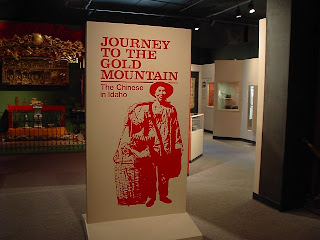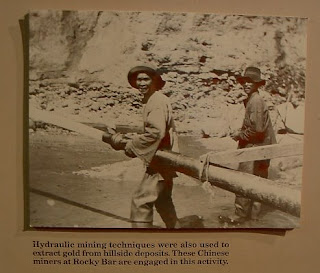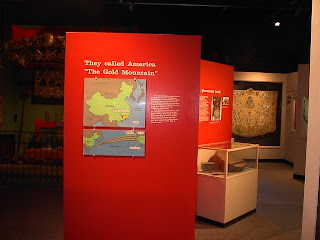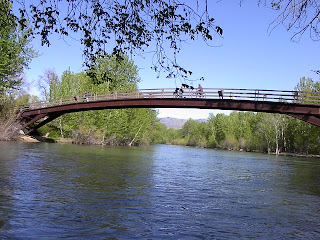 They developed as mining towns and started about the same period that coincided with the history of mass migration of the Chinese out of their homeland in the mid 19th century. One was rich in tin and the other in gold. Migrants from the southern Chinese province of Guangdong ( 广东省l ) flocked to these places in search of their pot of gold and, to escape the misery of a war torn land.
They developed as mining towns and started about the same period that coincided with the history of mass migration of the Chinese out of their homeland in the mid 19th century. One was rich in tin and the other in gold. Migrants from the southern Chinese province of Guangdong ( 广东省l ) flocked to these places in search of their pot of gold and, to escape the misery of a war torn land.The Taiping (1851-1864) rebellion was raging in China. The new frontiers were in dire need of labors to open up the land. With the discovery of the treasures, ship loads of migrant from the villages make their way to the Gold & Silver Mountains.
 It was a pleasant when I first visited Boise, Idaho in the US and had a chance to drop in to the Idaho Historical Museum. In a section of the museum was the tale of the Chinese migrant who ventured to the Treasure Valley in the continuing wave of gold rush that started in California. The story sounded familiar, and the photograph of the miners holding the water piston was what I've seen back in my hometown too.
It was a pleasant when I first visited Boise, Idaho in the US and had a chance to drop in to the Idaho Historical Museum. In a section of the museum was the tale of the Chinese migrant who ventured to the Treasure Valley in the continuing wave of gold rush that started in California. The story sounded familiar, and the photograph of the miners holding the water piston was what I've seen back in my hometown too.The Boise basin is located in the Pacific Northwest & within the precinct of the Rockies. In its heyday, with a population of 3,900, nearly two-third of them at 1,700 were Chinese migrants. The majoriy working as miners. Sudden as they appeared and fast they vanished from the valley too. This could possibly be due to the fact that when the gold was exhausted the migrant tide receded to the costal cities. It could have been also a desire to return home after making their fortune. And it had also been culminated by the effect of the Exclusion Act of 1882.
"In 1856 a small party of Chinese from California entered the Rocky Mountains and reached the Boise Basin of what is now southern Idaho. They left no written record, but seventy-five years later the last survivor of that party, Wong Ying, told their story in the Idaho Statesman. His personal experience in the American West was typical frontier drama." (a)
Other than the miners, there was also a handful of the Chinese migrants in Boise town who were engaged as gardeners.
"The truck gardens operated by Chinaman in the Boise area yielded big returns as the climate was more favorable than in Idaho City or Silver City. Their favorite carryall was two baskets swung from a yoke, curving around the neck and balanced across the shoulders. Fifteen to twenty miles a day was the average ordinary mileage by foot. They could not afford the stage." (b)
 “But the gardens themselves were beautiful, beautiful things to behold…..row after row of beautiful growing vegetables. They were neat and orderly. It was all done by hand.” – Boise resident describing the Chinese gardens / Idaho Historical Museum.
“But the gardens themselves were beautiful, beautiful things to behold…..row after row of beautiful growing vegetables. They were neat and orderly. It was all done by hand.” – Boise resident describing the Chinese gardens / Idaho Historical Museum.These vegetable gardeners left a name in the city that reminded us of their existence. A fellow colleague said that Chinden Boulevard, a main road in Boise, is derived from the phrase Chinese Garden. The road possibly passed thro the vegetable gardens ploughed by the entrepreneurial minded and industrious migrants who were there to make their buck.
At the same time, other groups of migrants from Guangdong province migrated to the tropical Nanyang ( 南洋 - South Sea) via the Lion City. They proceeded up country from this transit point and ventured to the Silver state in Malaya Peninsula. Tin was discovered in abundance in the Kinta Valley, and a Silver rush followed its heel.
Epoh became the adminstrative center for the many mining towns that opened up in this Treasure Valley. The town prospered. It once pride herself as the town with the biggest concentration of Towkays in the peninsula. After the Pacific War ended, many of those who ventured out as young men in the late 19th century, had wanted to return to their villages with their brood & fortune to enjoy their twilight years. However their dreams were thrown awry by the grave political situation back home. Their descendants stayed put and took roots in the Kinta Valley. They grown to become fine citizens of their new land.
Retrospective:
 1. First trip to Boise was in May 2002. It was early summer and the valley was lush with greenery. Boise came from the French word ‘les Bois’:
1. First trip to Boise was in May 2002. It was early summer and the valley was lush with greenery. Boise came from the French word ‘les Bois’:“Well, history shows that the French explorer who discovered Boise exclaimed, "Les Bois, Les Bois, voi Les Bois!" when he saw the fertile Boise river valley for the first time decades ago. The literal translation is "the trees, the trees, see the trees!"
The Idaho Historic Museum pictures were taken during that trip.
2. Visited Boise again last month. The temperature dropped to -10C and there was a light snow on the morning of 20Jan2007.
Reference:
c) http://www.idahohistory.net/museum.html
d) http://www.lebois.com/
/-